Post-Processing of Raw Data Recorded Continuously Using a FORS—Fibre-Optic Rotational Seismograph
Abstract
:1. Introduction
2. FOS5—Fibre-Optic Rotational Seismograph Construction
3. Results
3.1. Investigation and Processing of Device Self-Noise
3.2. Optimisation of Data Transfer Rate and File Size
3.3. Automatic Elimination of Artefacts from Recorded Data
4. Discussion
Author Contributions
Funding
Institutional Review Board Statement
Informed Consent Statement
Data Availability Statement
Conflicts of Interest
References
- Cusano, A.; Consales, M.; Crescitelli, A.; Ricciardi, A. Lab-on-Fibre Technology; Springer Series in Surface Science 56; Springer: Cham, Switzerland, 2015. [Google Scholar] [CrossRef]
- Russel, P. Photonic crystal fibers. Science 2003, 299, 358–362. [Google Scholar] [CrossRef] [PubMed]
- Knight, J.C. Photonic crystal fibers. Nature 2003, 424, 847–851. [Google Scholar] [CrossRef] [PubMed]
- Ziemann, O.; Krauser, J.; Zamzow, P.E.; Daum, W. POF Handbook: Optical SHORT Range Transmission Systems; Springer: Berlin, Germany, 2008. [Google Scholar]
- Van Zijkelenborg, M.A.; Large, M.C.J.; Argyros, A.; Zagari, J.; Manos, S.; Issa, N.A.; Bassett, A.; Fleming, S.; McPhedran, R.C.; Sterke, C.M.d.; et al. Microstructured polymer optical fibre. Opt. Express 2001, 9, 319–321. [Google Scholar] [CrossRef] [PubMed]
- Caming, J. Fibre gratings and devices for sensors and lasers. Laser & Photon. Rev. 2008, 2, 275–289. [Google Scholar] [CrossRef]
- Li, Q.-S.; Zhang, X.-L.; Shi, J.-G.; Xiang, D.; Zheng, L.; Yang, Y.; Yang, J.-H.; Feng, D.; Dong, W.-F. An Ultrasensitive Long-Period Fiber Grating-Based Refractive Index Sensor with Long Wavelengths. Sensors 2016, 16, 2205. [Google Scholar] [CrossRef] [Green Version]
- Zawisza, R.; Eftimov, T.; Mikulic, P.; Bock, W.J.; Jaroszewicz, L.R. Ambient Refractive-Index Measurement with Simultaneous Temperature Monitoring Based on a Dual-Resonance Long-Period Grating Inside a Fiber Loop Mirror Structure. Sensors 2018, 18, 2370. [Google Scholar] [CrossRef] [Green Version]
- Choochalerm, P.; Martin, W.E.; Jones, H.R.A.; Errmann, R.; Yerolatsitis, S.; Wright, T.A.; Buisset, C. Transmission properties of tapered optical fibres: Simulations and experimental measurements. Opt. Fiber Technol. 2021, 66, 102632. [Google Scholar] [CrossRef]
- Korec, J.; Stasiewicz, K.A.; Jaroszewicz, L.R.; Piecek, W.; Kula, P. Temperature and voltage sensing based on a tapered optical fiber device with the liquid crystal cladding. Opt. Fiber Technol. 2020, 56, 102190. [Google Scholar] [CrossRef]
- Mos, J.E.; Stasiewicz, K.A.; Garbat, K.; Morawiak, P.; Piecek, W.; Jaroszewicz, L.R. Tapered fiber liquid crystal hybrid broad band device. Phys. Scr. 2018, 93, 12502. [Google Scholar] [CrossRef]
- Iadicicco, A.; Campopiano, S.; Paladino, D.; Cutolo, A.; Cusano, A. Micro-structured fiber Bragg gratings: Optimization of the fabrication process. Opt. Express 2007, 15, 1511–1521. [Google Scholar] [CrossRef]
- Quero, G.; Crescitelli, A.; Paladino, D.; Consales, M.; Buosciolo, A.; Giordano, M.; Cutolo, A.; Cusano, A. Evanescent wave long-period fiber grating within D-shaped optical fibers for high sensitivity refractive index detection. Sens. Actuators B Chem. 2011, 152, 196–205. [Google Scholar] [CrossRef]
- Aconsales, M.; Riccisrdi, A.; Crescietelli, A.; Esposito, E.; Cutolo, A.; Cusano, A. Lab-on-fiber technology towards multi-functional optical nanoprobes. ACS Nano 2012, 6, 3163–3170. [Google Scholar] [CrossRef] [PubMed]
- Bachelot, R.; Blaize, S.; Pang, C.; Bruyant, A.; Royer, P. Polymer-Tipped Optical Fibers. Fiber Integr. Opt. 2008, 27, 542–558. [Google Scholar] [CrossRef]
- Marc, P.; Zukowska, M.; Jakubowska, I.; Jaroszewicz, L.R. Polymer microtip on a multimode optical fiber as a threshold volatile organic compounds sensor. Sensors 2022, 22, 1246. [Google Scholar] [CrossRef] [PubMed]
- Lee, B.H.; Kim, Y.H.; Park, K.S.; Eom, J.B.; Kim, M.J.; Rho, B.S.; Choi, H.Y. Interferometric Fiber Optic Sensors. Sensors 2012, 12, 2467–2486. [Google Scholar] [CrossRef] [PubMed] [Green Version]
- Stolen, R.H.; Ashkin, A. Optical Kerr effect in glass waveguide. Appl. Phys. Lett. 1973, 22, 294. [Google Scholar] [CrossRef]
- Mihailovic, P.; Petricevic, S. Fiber Optic Sensors Based on the Faraday Effect. Sensors 2021, 21, 6564. [Google Scholar] [CrossRef]
- Arditty, H.J.; Lefèvre, H.C. Sagnac effect in fiber gyroscopes. Opt. Lett. 1981, 6, 401–403. [Google Scholar] [CrossRef]
- Lefèvre, H.C. Principle of the Fiber-Optic Gyroscope. In The Fiber-Optic Gyroscope, 2nd ed.; Lefèvre, H.C., Ed.; Artech House: London, UK, 2014. [Google Scholar]
- Arditty, H.J.; Graindorge, P.; Lefèvre, H.C.; Martin, P.; Morisse, J.; Simonpiétri, P. Fiber-Optic Gyroscope with All-Digital Processing. In Proceedings of the OFS 6/’89, Paris, France, September 1989; Springer: Berlin/Heidelberg, Germany, 1989; Volume 44, pp. 131–136. [Google Scholar]
- Lefèvre, H.C.; Martin, P.; Morisse, J.; Simonpietri, P.; Vivenot, P.; Arditty, H.J. High Dynamic Range Fiber Gyro with All-Digital Processing. SPIE Proc. 1990, 1367, 72–80. [Google Scholar] [CrossRef]
- Lee, W.H.K.; Çelebi, M.; Todorovska, M.I.; Igel, H. Introduction to the Special Issue on Rotational Seismology and Engineering Applications. Bull. Seismol. Soc. Am. 2009, 99, 945–957. [Google Scholar] [CrossRef]
- Jaroszewicz, L.R.; Kurzych, A.; Krajewski, Z.; Marć, P.; Kowalski, J.K.; Bobra, P.; Zembaty, Z.; Sakowicz, B.; Jankowski, R. Review of the Usefulness of Various Rotational Seismometers with Laboratory Results of Fibre-Optic Ones Tested for Engineering Applications. Sensors 2016, 16, 2161. [Google Scholar] [CrossRef] [PubMed] [Green Version]
- Bernauer, F.; Wassermann, J.; Igel, H. Rotational sensors—A comparison of different sensor types. J. Seismol. 2012, 16, 595–602. [Google Scholar] [CrossRef]
- Havskov, J.; Alguacil, G. Instrumentation in Earthquake Seismology, 2nd ed.; Springer: Cham, Swittzerland, 2016. [Google Scholar]
- Izgi, G.; Eibl, E.P.S.; Donner, S.; Bernauer, F. Performance Test of the Rotational Sensors blueSeis-3A in a Huddle Test in Furstenfeldbruck. Sensors 2021, 21, 3170. [Google Scholar] [CrossRef] [PubMed]
- Kurzych, A.; Jaroszewicz, L.R.; Krajewski, Z.; Sakowicz, B.; Kowalski, J.K.; Marć, P. Fibre-Optic Sagnac Interferometer in a FOG Minimum Configuration as Instrumental Challenge for Rotational Seismology. J. Lightwave Technol. 2018, 36, 879–884. [Google Scholar] [CrossRef]
- Bernauer, F.; Behnen, K.; Wassermann, J.; Egdorf, S.; Igel, H.; Donner, S.; Stammler, K.; Hoffmann, M.; Edme, P.; Sollberger, D.; et al. Rotation, Strain and Translation Sensors Performance Tests with Active Seismic Sources. Sensors 2021, 21, 264. [Google Scholar] [CrossRef]
- Kurzych, A.T.; Jaroszewicz, L.R.; Dudek, M.; Sakowicz, B.; Kowalski, J.K. Towards uniformity of rotational events recording—Initial data from common test engaging more than 40 sensors including a wide number of fiber-optic rotational seismometers. Opto-Electron. Rev. 2021, 29, 39–44. [Google Scholar] [CrossRef]
- Jaroszewicz, L.R.; Krajewski, Z.; Teisseyre, K.P. Usefulness of AFORS—Autonomous Fibre-Optic Rotational Seismograph for investigation of rotational phenomena. J. Seismol. 2012, 16, 573–586. [Google Scholar] [CrossRef]
- Kurzych, A.; Jaroszewicz, L.R.; Krajewski, Z.; Teisseyre, K.P.; Kowalski, J.K. Fibre-Optic System for Monitoring Rotational Seismic Phenomena. Sensors 2014, 14, 5459–5469. [Google Scholar] [CrossRef] [Green Version]
- Kurzych, A.; Kowalski, J.K.; Sakowicz, B.; Krajewski, Z.; Jaroszewicz, L.R. The laboratory investigation of the innovative sensor for torsional effects in engineering structures’ monitoring. Opto-Electron. Rev. 2016, 24, 134–143. [Google Scholar] [CrossRef]
- Kurzych, A.T.; Jaroszewicz, L.R.; Krajewski, Z.; Dudek, M.; Teisseyre, K.P.; Kowalski, J.K. Two correlated interferometric optical fiber systems applied to the mining activity recordings. J. Lightwave Technol. 2019, 37, 4851–4857. [Google Scholar] [CrossRef]
- Kurzych, A.T.; Jaroszewicz, L.R.; Kowalski, J.K.; Sakowicz, B. Investigation of rotational motion in a reinforced concrete frame construction by a fiber optic gyroscope. Opto-Electron. Rev. 2020, 28, 69–73. [Google Scholar] [CrossRef]
- Jaroszewicz, L.R.; Dudek, M.; Kurzych, A.T.; Teisseyre, K.P. A test performance of fibre-optic sensors for real-time investigations of rotational seismic events: A case study in laboratory and field conditions. Opto-Electron. Rev. 2021, 29, 213–219. [Google Scholar] [CrossRef]
- Michelson, A.A.; Gale, H.G. The Effect of the Earth’s Rotation on the Velocity of Light. Nature 1925, 115, 566. [Google Scholar] [CrossRef]
- Li, Y.; Cao, Y.; He, D.; Wu, Y.; Chen, F.; Peng, C.; Li, Z. Thermal phase noise in giant interferometric fiber optic gyroscopes. Opt. Express 2019, 27, 14121–14132. [Google Scholar] [CrossRef] [PubMed]
- Bernauer, F.; Wassermann, J.; Guattari, F.; Frenois, A.; Bigueur, A.; Gaillot, A.; de Toldi, E.; Ponceau, D.; Schreiber, U.; Igel, H. BlueSeis3A: Full Characterization of a 3C Broadband Rotational Seismometer. Seismol. Res. Lett. 2018, 89, 620–629. [Google Scholar] [CrossRef]
- Sleeman, R. Three-Channel Correlation Analysis: A New Technique to Measure Instrumentation Noise of Digitizers and Seismic Sensors. Bull. Seismol. Soc. Am. 2006, 96, 258–271. [Google Scholar] [CrossRef]
- Gonzalez, R. Digital Image Processing, 4th ed.; Pearson: New York, NY, USA, 2018. [Google Scholar]
- Konno, K.; Ohmachi, T. Ground motion characteristics estimated from spectral ratio between horizontal and vertical components of microtremor. Bull. Seismol. Soc. Am. 1998, 88, 228–241. [Google Scholar] [CrossRef]
- Nyquist, H. Certain Topics in Telegraph Transmission Theory. Trans. AIEE 1928, 47, 617–644. [Google Scholar] [CrossRef]
- Murray-Bergquist, L.; Bernauer, F.; Igel, H. Characterization of Six-Degree-of-Freedom Sensors for Building Health Monitoring. Sensor 2021, 21, 3732. [Google Scholar] [CrossRef]
- Bernauer, F. Bluesis-Sandbox. 6 June 2019. Available online: https://github.com/fbernauer/blueseis_sandbox (accessed on 4 October 2022).
- Standard for the Exchange the of Earthquake Data—Reference Manual, 4th ed.; IRIS: Seattle, DC, USA, 2012.
- Laudat, T.; de Toldi, E.; Guattari, F. Rotation ground motion instrumentation: blueSeis continues its quest for innovation. In Proceedings of the 5th International Working Group on Rotational Seismology Meeting, Sum Moon Lake, Taiwan, 22–26 September 2019. [Google Scholar]
- Good, P.I. Resampling Methods: A Practical Guide to Data Analysis, 3rd ed.; Birkhauser Verlag GmbH: Basel, Switzerland, 2006. [Google Scholar]
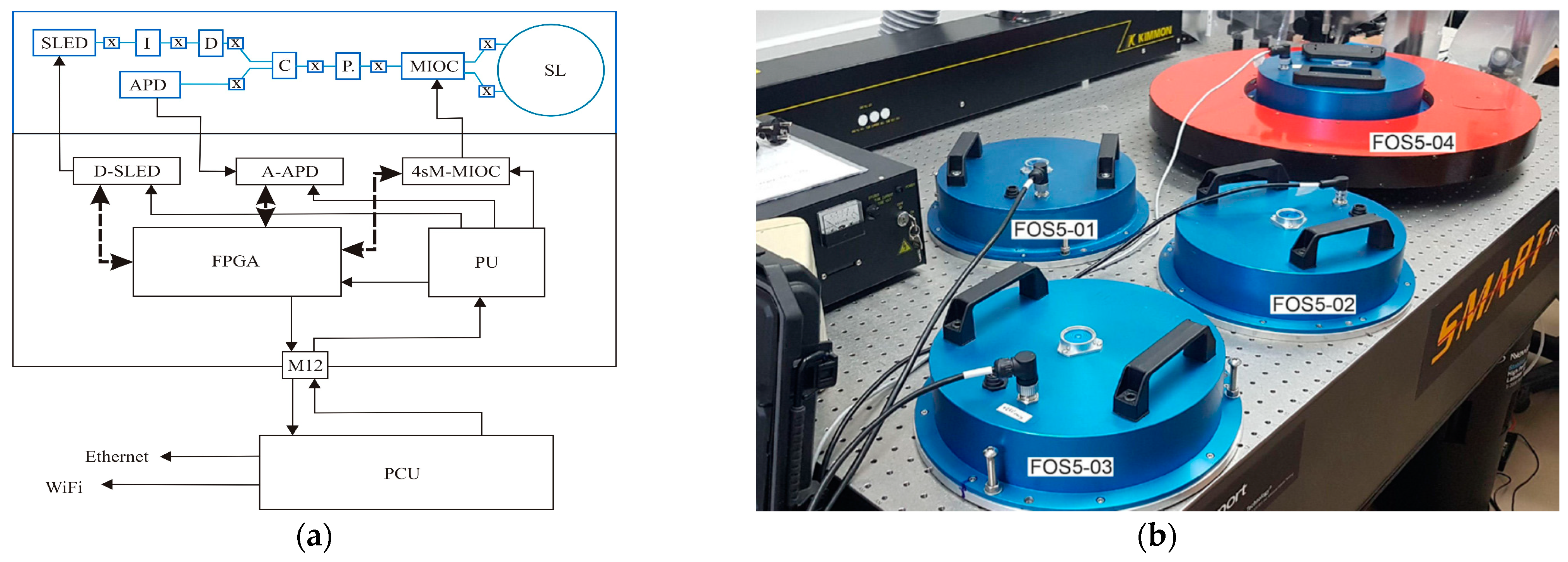
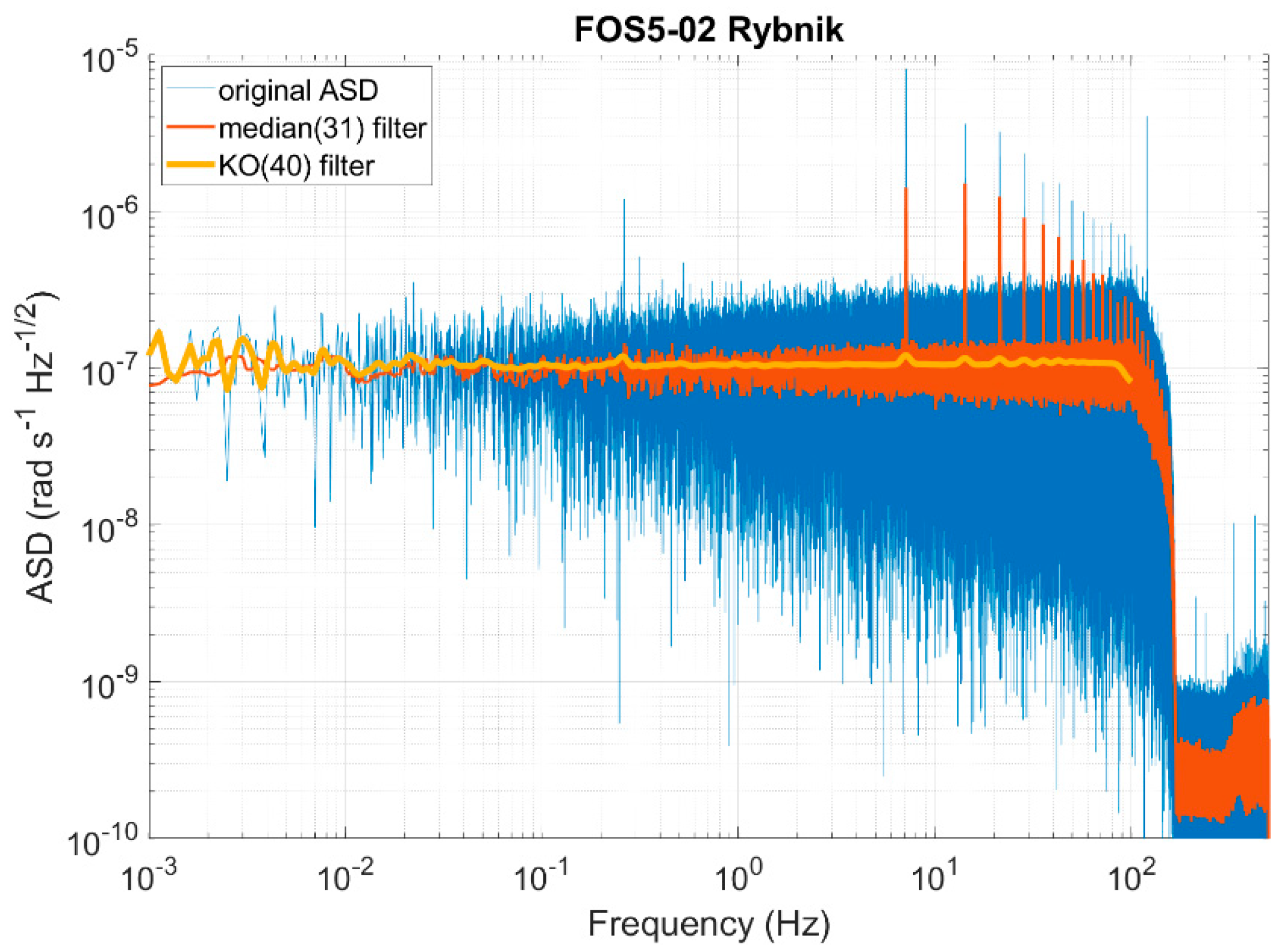
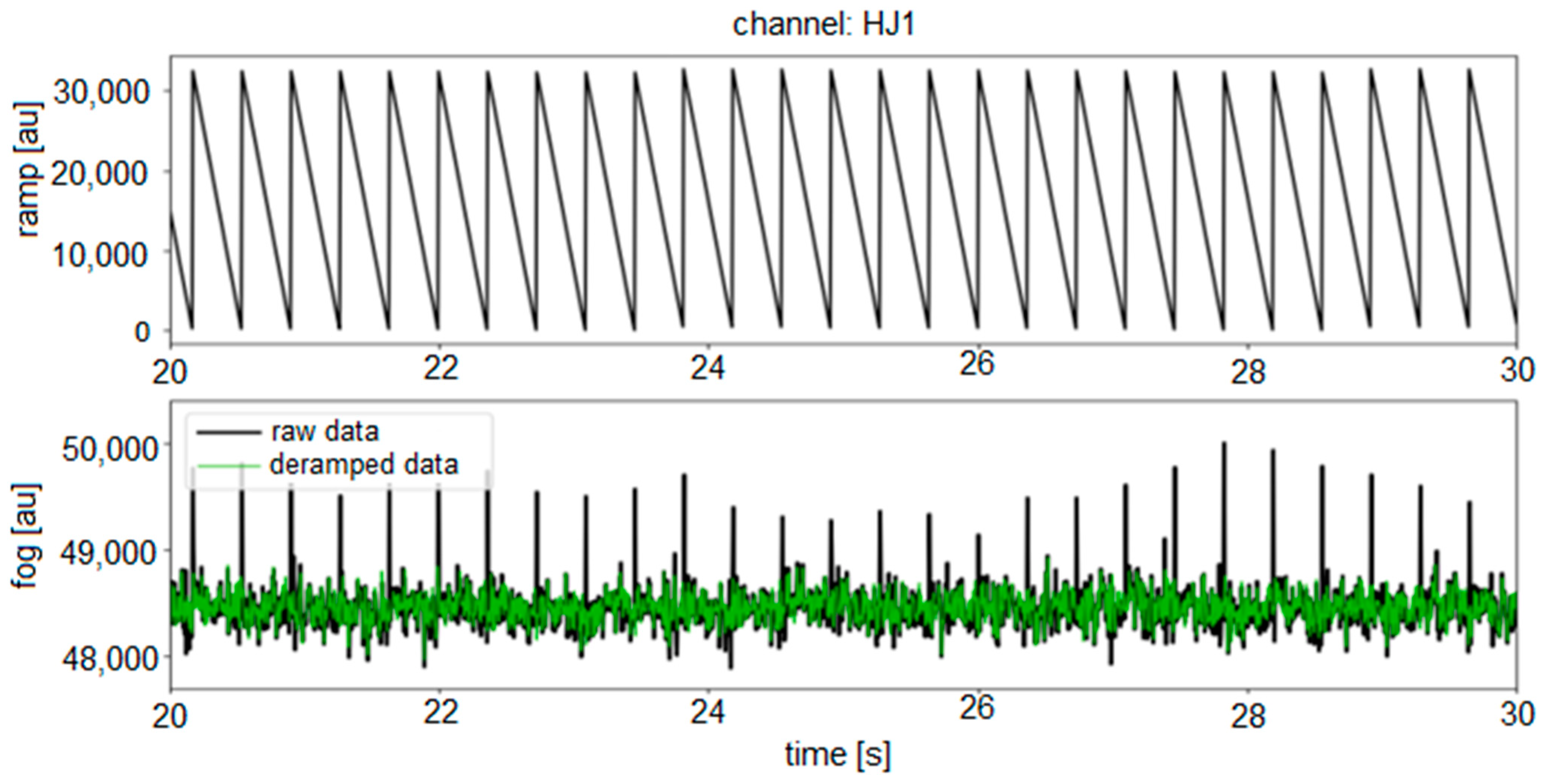

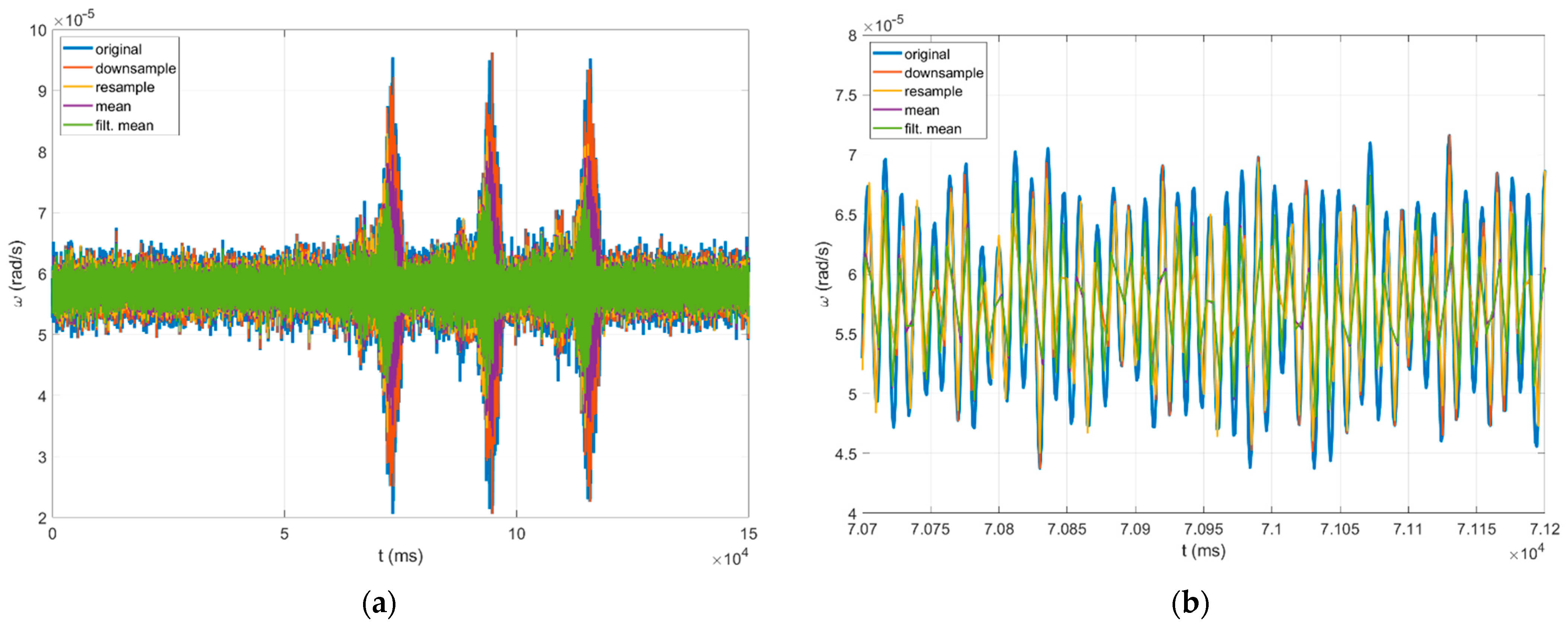
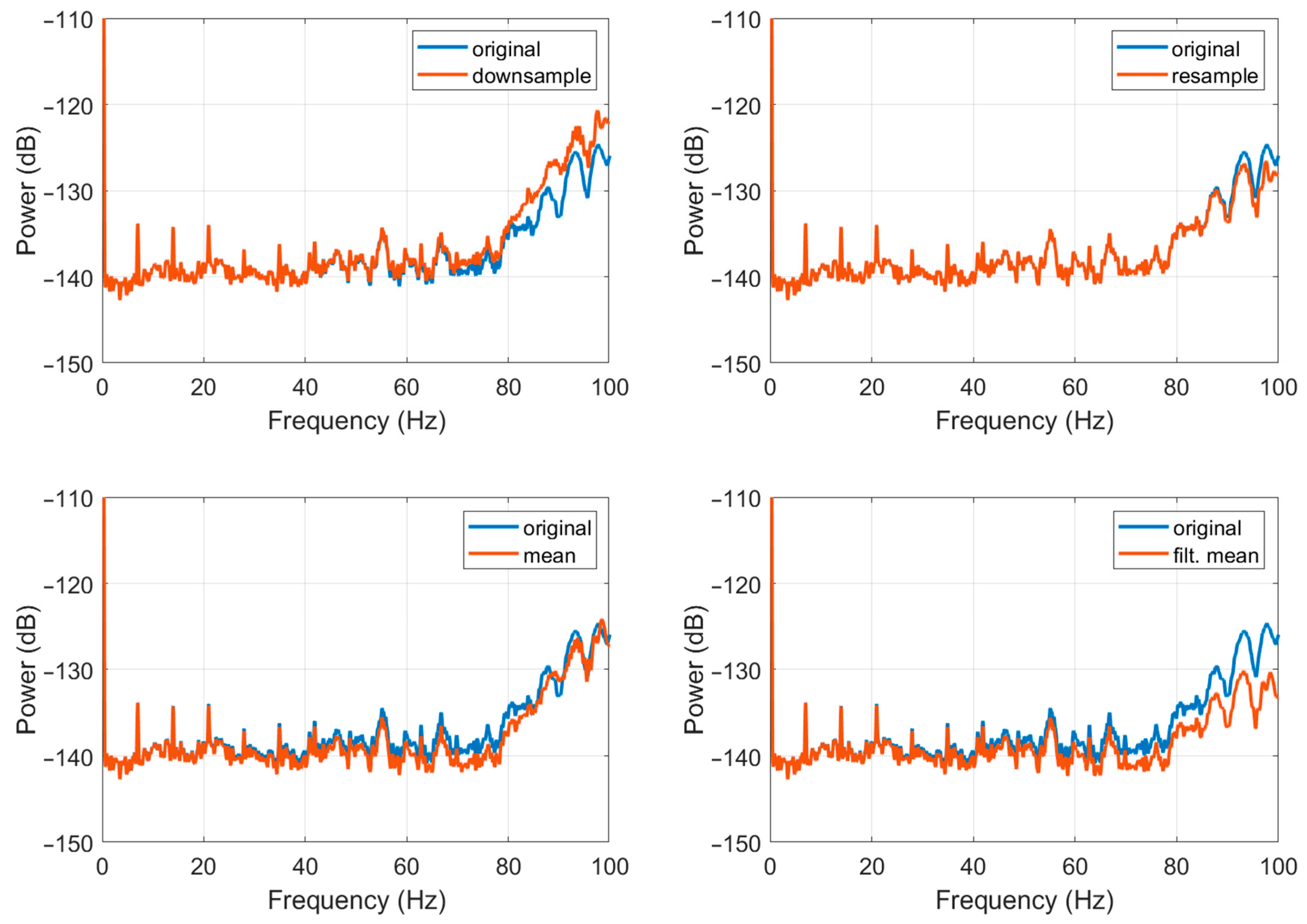

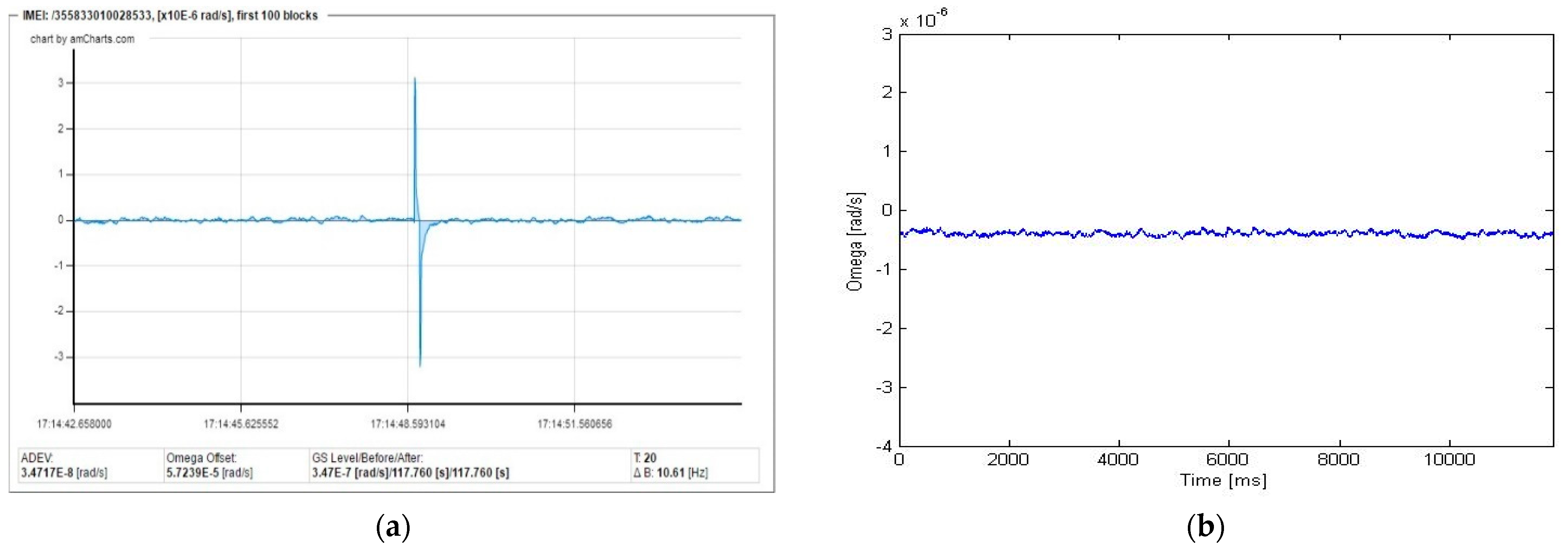
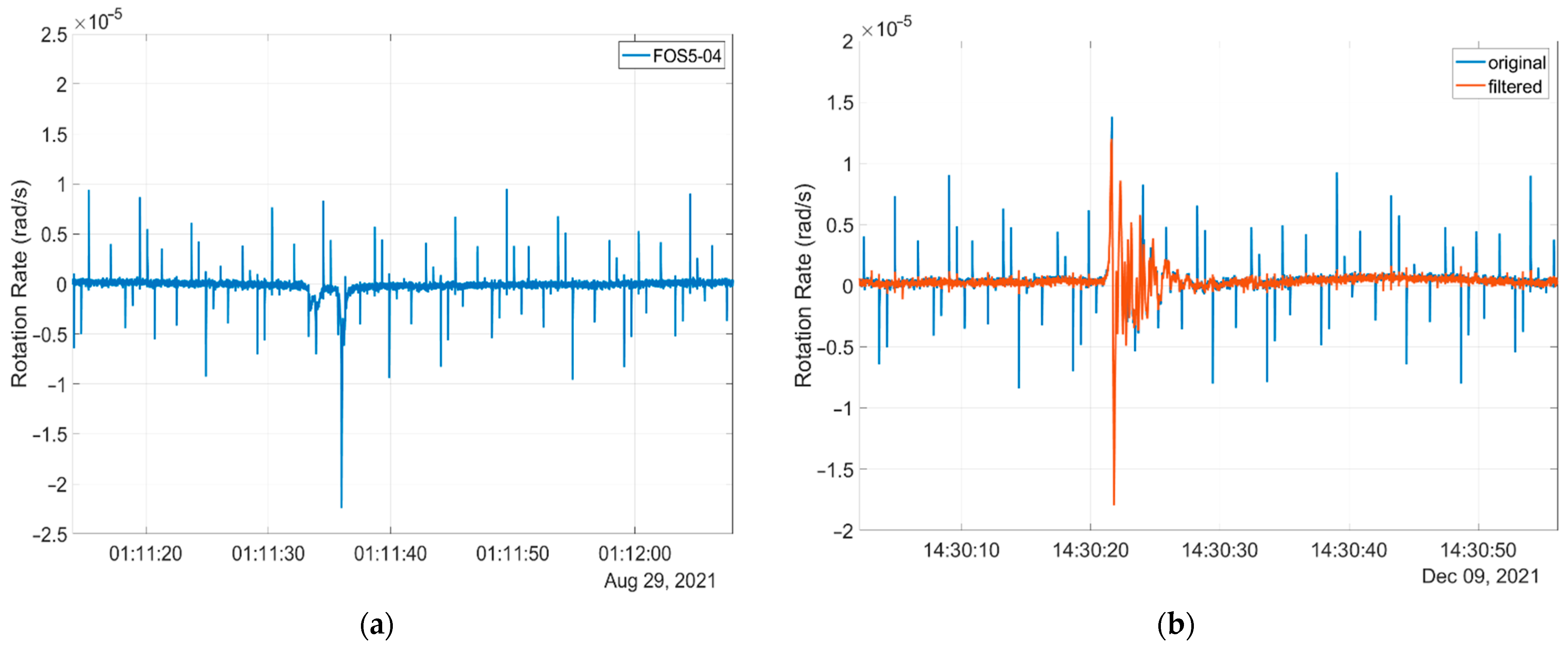
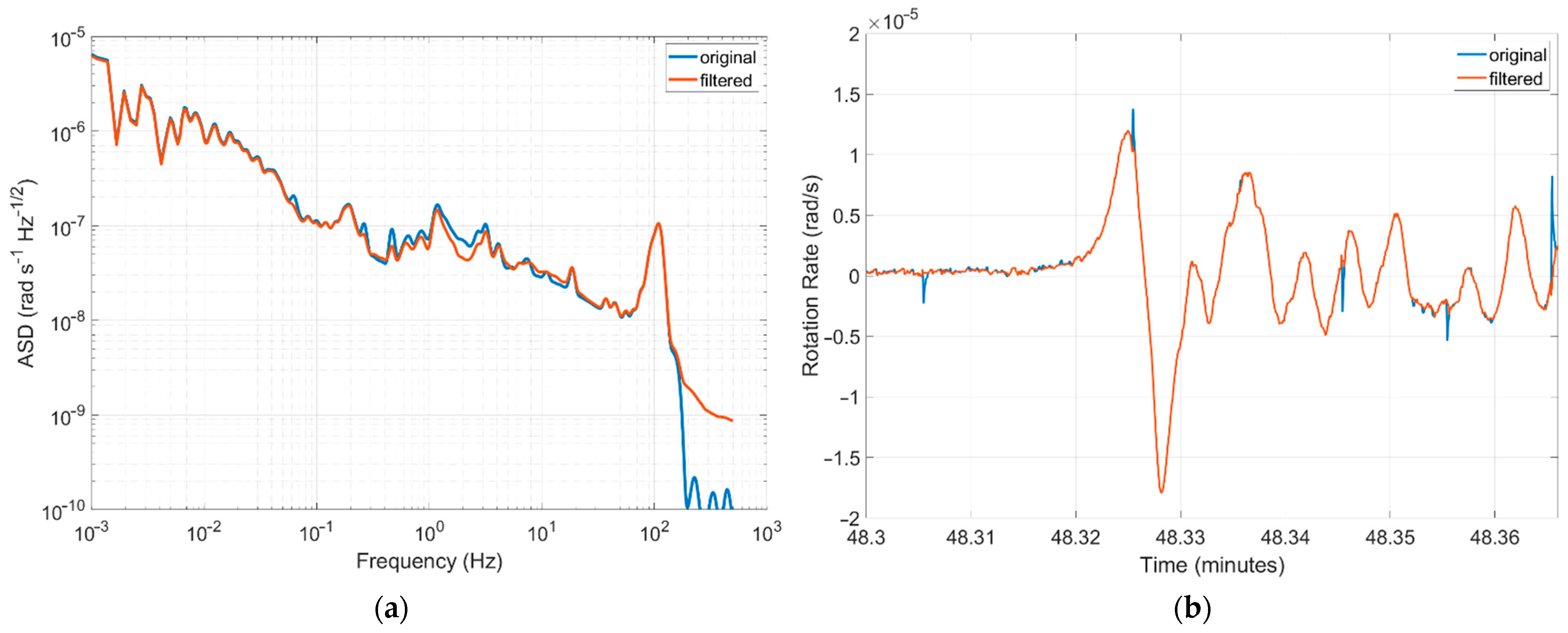
Publisher’s Note: MDPI stays neutral with regard to jurisdictional claims in published maps and institutional affiliations. |
© 2022 by the authors. Licensee MDPI, Basel, Switzerland. This article is an open access article distributed under the terms and conditions of the Creative Commons Attribution (CC BY) license (https://creativecommons.org/licenses/by/4.0/).
Share and Cite
Sakowicz, B.; Kamiński, M.; Dudek, M.; Kurzych, A.T.; Jaroszewicz, L.R. Post-Processing of Raw Data Recorded Continuously Using a FORS—Fibre-Optic Rotational Seismograph. Sensors 2022, 22, 8673. https://doi.org/10.3390/s22228673
Sakowicz B, Kamiński M, Dudek M, Kurzych AT, Jaroszewicz LR. Post-Processing of Raw Data Recorded Continuously Using a FORS—Fibre-Optic Rotational Seismograph. Sensors. 2022; 22(22):8673. https://doi.org/10.3390/s22228673
Chicago/Turabian StyleSakowicz, Bartosz, Marek Kamiński, Michał Dudek, Anna T. Kurzych, and Leszek R. Jaroszewicz. 2022. "Post-Processing of Raw Data Recorded Continuously Using a FORS—Fibre-Optic Rotational Seismograph" Sensors 22, no. 22: 8673. https://doi.org/10.3390/s22228673







